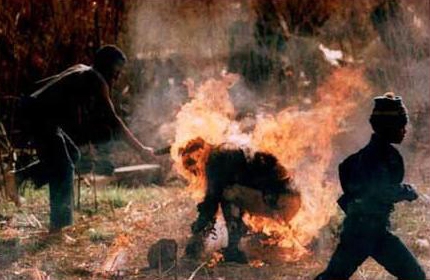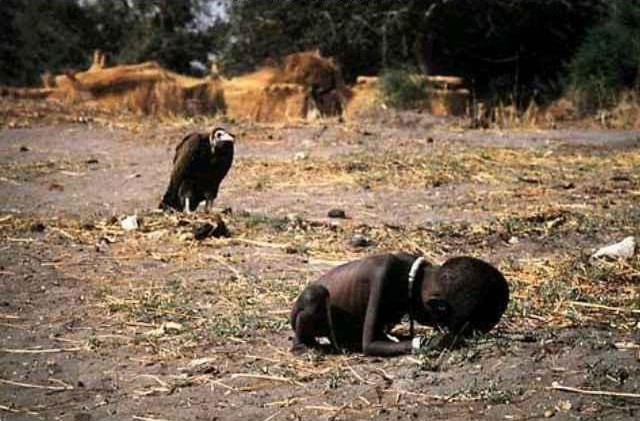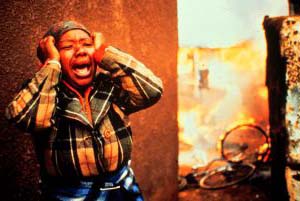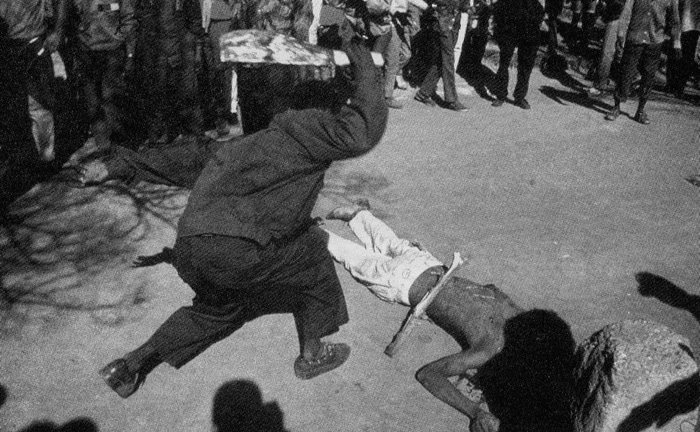~Article by Trompie van der Berg…
The movie, “The Bang Bang Club” started showing at cinemas during the past week. I too, went to see the movie. In my opinion, it really is a must-see for every photographer. It is not a movie for kids or very sensitive people as the content is quite graphic. It is a movie that has left a mark on me and made me ask questions about myself and my own morality and just how far I am willing to go as a photographer. It also brings up the questions if my photographs really show the “real” story or if it is me who is the sculptor of the scene and only a projection of what I want people to see. I love my street photography and on many occasions have been presented with the situation where you are “paying off” a homeless person to get the shot you are after. Where you catch people at their most vulnerable and take the shot in a very detached way. We aim to show the hard life by getting the weary eyes in sharp focus, we compose to get the bare cracked feet in the shot, the makeshift home of cardboard boxes to add to the drama, I sometimes forget that there is a person behind that picture I am taking. The movie made me think, go and see it and make up your own mind…Here’s a brief history of what the Bang Bang club was all about…The Bang Bang Club is the name primarily associated with four photographers active within the townships of South Africa during the Apartheid period, particularly between 1990 and 1994. Kevin Carter, Greg Marinovich, Ken Oosterbroek, and Joao Silva are the four associated with the name.The name “The Bang Bang Club” was born out of an article published in the South African magazine Living. Originally named The Bang Bang Paparazzi, it was changed to “Club” because the members felt the word paparazzi misrepresented their work. The name comes from the culture itself; township residents spoke to the photographers about the “bang-bang” in reference to violence occurring within their communities, but more literally, “bang-bang” refers to the sound of gunfire and is a general phrase used by conflict photographers.Two members won Pulitzer Prizes for their photography in the space of 4 years; Greg Marinovich and Kevin Carter. Marinovich won the Pulitzer for Sports and News in 1991 for his shocking photograph of the killing of Lindshaye Tsabalala in 1990.

Greg Marinovich won the Pulitzer for Sports and News in 1991 for his shocking photograph of the killing of Lindshaye Tsabalala in 1990.
Carter won the Pulitzer for Featured Photographer in 1994 for his 1993 photograph of a vulture that appeared to be stalking a starving child in southern Sudan.

Kevin Carter won the Pulitzer for Featured Photographer in 1994 for his 1993 photograph of a vulture that appeared to be stalking a starving child in southern Sudan.
These four photographers because of their graphic work and the often detached way they did it in started the conversation of morality in photography and if a photograph really tells the entire story. An excerpt out of the book “The Bang Bang Club”, Greg Marinovich gives us an insight into the photograph he took that won him the Pulitzer.Greg finds himself in the middle of an unruly mob of Zulus spearing and hacking a Xhosa enemy to death. “I was one of the circle of killers, shooting with a wide-angle lens just an arm’s length away, much too close,” Marinovich and Silva write in the book, from narrator Marinovich’s viewpoint. “I was horrified, screaming inside my head that this could not be happening. But I steadily checked light readings and switched between cameras loaded with black-and-white and colour, rapidly advancing the film frame by frame. I was as aware of what I was doing as a photographer was of the rich scent of fresh blood, and the stench of sweat from the men next to me.”The same goes for the photograph taken by Kevin Carter of the vulture and child that won him his Pulitzer. An excerpt out of the book to demonstrate the detachment these photographers did their work with.”He heard a soft, high-pitched whimpering and saw a tiny girl trying to make her way to the feeding center. As he crouched to photograph her, a vulture landed in view. Careful not to disturb the bird, he positioned himself for the best possible image. He would later say he waited about 20 minutes, hoping the vulture would spread its wings. It did not, and after he took his photographs, he chased the bird away and watched as the little girl resumed her struggle.” This picture earned Carter the 1994 Pulitzer Prize for feature photography. “I swear I got the most applause of anybody,” Carter wrote back to his parents in Johannesburg. “I can’t wait to show you the trophy. It is the most precious thing and the highest acknowledgment of my work I could receive.” Carter’s joy would not last. Friends and colleagues would come to question why he had not done more to help the child in the photograph? “The man adjusting his lens to take just the right frame of her suffering,” said the St. Petersburg (Florida) Times, “might just as well be a predator, another vulture on the scene.” Burdened with feelings of guilt and sadness, Kevin Carter took his own life On July 27, 1994. His suicide note stated in part, “…I am haunted by the vivid memories of killings and corpses and anger and pain . . . of starving or wounded children…” He committed suicide by taping one end of a hose to his pickup truck’s exhaust pipe and running the other end to the passenger-side window. He died of carbon monoxide poisoning on July 27, 1994, at the age of 33. Ken Oosterbroek was killed by friendly-fire in the Thokoza township on April 18, days prior to the 1994 elections in South Africa, the country’s first free elections. He and other photographers were covering a clash between peacekeepers and the ANC when the peacekeepers opened fire and shot Oosterbroek and fellow Bang-Bang Club member Greg Marinovich. One of Ken’s most memorable pictures…
Joao Silva continued to take war photographs and last year he was in the news when he covered the war in Afghanistan and stepped on an antipersonnel mine which blew off his legs. It is said that while waiting to be evacuated Silva kept on taking photographs of the scene! One of Joao’s photographs below…





I cried my heart out for my beloved country…so graphically portrayed in this excellent, outstanding movie!
i have a deep appreciation for the wonderful insight yet dangerous work photographers do…they record life for us to view in the security of our homes.The morality-debate on what and when to photograph whatever is possibly the biggest dilemma they face.
I’ve just come back from watching this movie. It’s never going to be a blockbuster. It does not have an edge of the seat story-line and there is some iffish acting and dialogue at times, but hell, what an emotional ride. There were times when it really all got to me. I could only imagine what those guys went through, being right there in the face of all that racial turmoil. Most of the attention in the movie is on the two Pullitzer prize winners, but I really had a feeling of loss when Ken OOsterbroek was killed. It made me realise that they were all in a mental war of their own. It is small wonder that Kevin Carter took his own life. Being a junky must have had him always at the edge. The bit of street photography I have done pales in comparison with what these guys endured. A great story.
These images chills to the bone. Food for thought. I have always admired photojournalists, this puts a different spin on my view. thx Trompie.
An excellent review and disturbing images. We need to think as photographers, what we are doing and the deeper meaning of it all, if any.